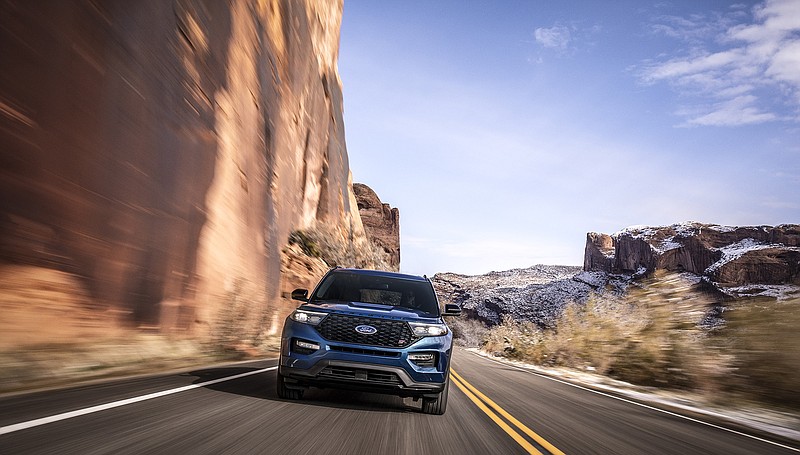ord Explorer, you had me at ST. I'm a big believer in "halo" cars, those goosebump-inducing, chart-topping performance variants that speak volumes about a car model's aspirations and engineering, and bring people into showrooms. Think Dodge Hellcat, Jeep Rubicon, BMW M3, GMC Denali, Volkswagen GTI.
For the first time ever, the familiar ol' Explorer three-row SUV has adopted Ford's hellion ST badge-and it's like tossing Roger Federer an oversize graphite racket. It gives Explorer a better all-around game. It's got 400 horsepower, has more black makeup than Alice Cooper, and will land dad in jail if he takes it to a back road.
And that's a good thing in the ferociously competitive three-row SUV rugby scrum, where you either stand out or get ground into the turf.
The Explorer, of course, is-along with the Jeep Grand Cherokee-one of the pioneers of the midsize SUV segment. They dominated the class for years, selling zillions and printing more money than Daddy Warbucks thanks to building on an existing pickup chassis.
Then Ford woke up a decade ago and realized that every other automaker had jumped into the segment.
There were unibody-based Toyota Highlanders and stonkin' Dodge Durango R/Ts and spacious Chevy Traverses. Heck, even Jeep had sprouted a Trackhawk variant with something like 15,000 horsepower and a V-8 mating call that made every grown male howl at the moon.
So Dearborn got busy and the all-new 2020 Explorer is the result. It advances on Ford's first 2011 unibody SUV in every conceivable way. It would take five columns to cover the highlights of this car, but let me sum the Explorer up this way: It's a handsome, rear- and all-wheel drive, nice-handling 4,700-pound school bus. It's off-road capable, roomy, high-tech, detail-rich and ergonomically smart.
(Pause to catch breath)
It's a powerful, quiet, connected crossover with a one-touch autonomous self-parking feature that will have your neighbor who just bought an Audi for $20,000 more running over for a demo.
Even with all that, sales champ Explorer was going to be under pressure to hold off value plays like the Kia Telluride and Toyota Highlander.
So, like Federer watching tape between matches, Explorer went out and augmented its core design and technology strengths by adopting the competition's best features.
For years Explorer has been the fashion plate of SUVs. Like the lovely Fusion sedan copying Aston's face, Ford knows a beaut when it sees it one. Explorer cribbed SUV heartthrob Range Rover's wardrobe, right down to the Brit's stylish bonnet lettering, E-X-P-L-O-R-E-R.
Taking Rover's lesson one step further, the 2020 Explorer adopts a luxury-class longitudinal engine architecture that pushes the wheels out to the front corners. That creates a dramatic silhouette with long snout, scalloped shoulders and big haunches.
Nice ... but then the designers took the rest of the day off.
Where Range Rover's design (check out the Velar, and bring a drool bucket) is lean and Apple-spare, the Ford is over-designed in the front, giving its face a jowly, heavy appearance compared to the last generation. Liposuction, please.
Explorer takes a back seat to the crisp Kia Telluride as class prom queen.
Kia then adds insult to injury by making its front wheel drive-based beauty a cheap date. Endowed with a long list of standard features like adaptive cruise-control and blind-spot assist, a $41,845 all-wheel drive Telluride EX with 20-inch wheels and moonroof undercuts Explorer's similarly equipped, $47,405 Explorer XLT by a whopping $5,500.
Happily, Ford has put that rear-wheel drive based platform to other good uses.
Like Detroit rival Dodge Durango-another SUV in class with a rear wheel drive-based bod-the Explorer is engineered to be an athlete from the ground up.
Despite those jowls, the 2020 model is 200 pounds lighter than the 2019. Mated to Ford's base 2.3-liter workhorse turbo-4 (also found in the speedy Mustang and European Focus RS), the volume XLT Explorer can cut some rug on the dance floor and does a pretty good imitation of a Jeep off-road.
Bolt in the 400-horse twin-turbo V-6, and the Explorer transforms into a rhino in ballet slippers. I like the Mazda CX-9's nimble bod, but there's no high-horse performance variant. Only the R/T and SRT versions of the Durango play in this league.
Stomp the pedal and the Explorer thinks it's a Focus ST in an SUV body. The secretary of state should require a racing license to operate this Frankenstein's monster. Taut and responsive with the Explorer's standard 10-speed tranny throwing off quick upshifts, the three-row ST gulped pavement at an alarming rate in the hills of Portland's Columbia River valley.
What are you doing, Payne, this is a three-row ute!
And it's a usable three rows. Yes, Grand Cherokee's Hellcat-fueled, 707-horse Trackhawk has no peer. But you can only make three other adults sick in its two-row configuration. Thanks to that RWD-based architecture, Explorer has gained a healthy 4 inches of legroom behind the front seat, meaning you can put two 6-footers in the third row.
The Explorer isn't all looks and muscle. It's taken Ergonomics 101 from the Honda Pilot.
The three-row Pilot is homely compared to its glamorous classmates, but it geeks out on interior detail with its space-saving trigger shifter, console storage and one-button third-row access. Veteran Explorer chief engineer Bill Gubing and his team watched and learned.
The Explorer will win over the family with its attention to detail: Rotary shifter. Horizontal-or-vertical touchscreens. Single-button access to third row seats. Sub-cargo storage for muddy cleats. Rocker-panel foot-steps for Christmas tree-tying roof access ...
(Pause to catch breath)
... standard automatic rear-hatch. Sports-car-like, 2X hood release to save you from fishing for the release under the bonnet.
Only with its first hybrid does Explorer shy from the competition. Despite years of hybrid development, Ford prices it way out of reach-at a nose-bleed $53,000-from the excellent, $38,000 Highlander Hybrid.
Seems Ford would rather show off its pioneering electronics.
Like a luxury car, you'll be showing it off to your friends. There's the FordPass app that can remotely start your car, look in on tire pressures and vacuum Cheerios from under the seats (just kidding about that last part). And then there's self-park assist, part of Ford's must-have Co-Pilot360 driver-assist package. I spent an evening effortlessly parallel parking a giant, three-row SUV all over town by touching nothing but a button.
Which was relaxing after a day of wringing the Explorer ST's neck all over Oregon.
2020 Ford Explorer
Vehicle type: Front-engine, rear- and all-wheel drive, seven- or eight-passenger, three-row SUV
Price: Base price $37,770 for XLT including $1,095 destination charge ($46,130 AWD XLT and $54,740 AWD ST as tested)
Powerplant: 2.3-liter, turbocharged 4-cylinder; hybrid 3.3-liter V-6 mated to AC electric motor (hybrid only); 3.0-liter, twin-turbo V-6 (ST and Platinum only)
Power: 300 horsepower, 310 pound-feet of torque; 318 horsepower, 322 torque combined (hybrid); 400 horsepower, 415 torque (ST); 365 horsepower, 380 torque (Platinum)
Transmission: 10-speed automatic
Performance: 0-60 mph, 5.5 sec. (ST, mfr.); maximum towing, 5,600 pounds
Weight: 4,345 pounds base RWD (4,701 AWD ST)
Fuel economy (all numbers with AWD): EPA: 20 city/27 highway/23 combined (2.3-L turbo-4); 18 city/24 highway/20 combined (3.0-L turbo-V6): N/A for hybrid model
Report card
Highs: ST hottie; one-button self-parking
Lows: Jowly face; gets pricey
Overall: 3 stars
ABOUT THE WRITER
Henry Payne is auto critic for The Detroit News. Find him at [email protected] or Twitter @HenryEPayne.



